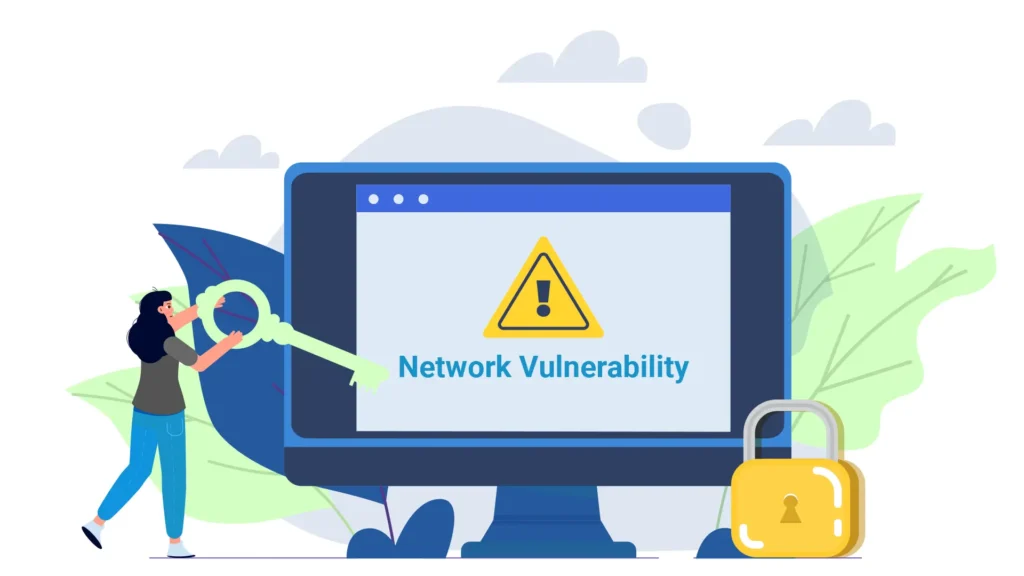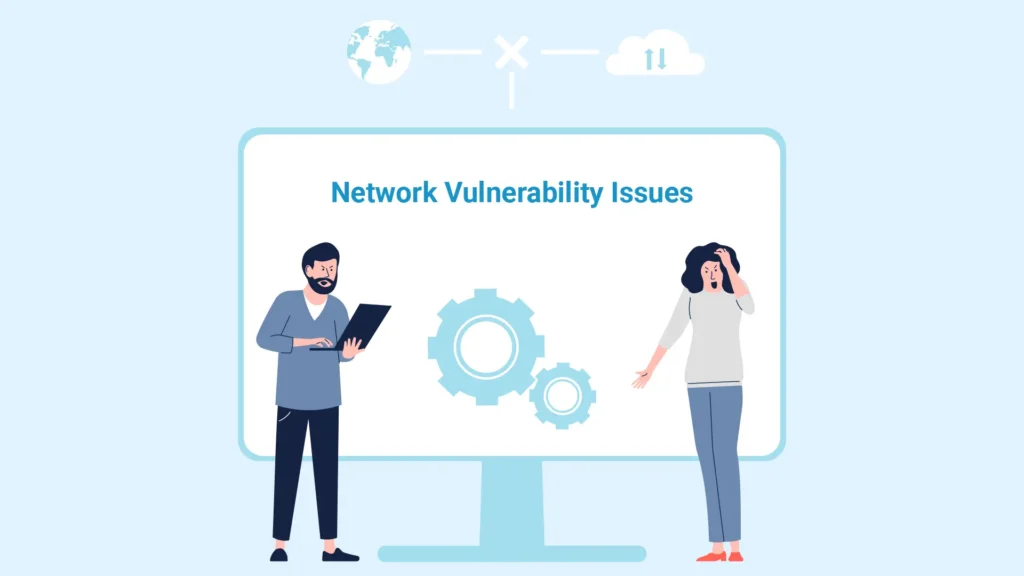Let’s talk about something really important: network vulnerability. It’s like having a secret door in your house that someone can sneak through if you don’t lock it properly. Businesses and regular folks like us need to pay attention to this because our whole digital world runs on networks. Imagine if your bank account or messages got into the wrong hands because of a network problem! Scary, right?
In this article, we’re going to explore what vulnerabilities in network mean and why they matter so much. We’ll look at the common types of vulnerabilities out there, how they can mess with businesses, ways to spot them, and what we can do to keep our networks safe from network vulnerability. It’s like learning the secret tricks to protect our digital homes from intruders. Sounds interesting, doesn’t it? Let’s dive in and learn together!
What is a Network Vulnerability?
Your network is like a fortress protecting precious treasures. Network security vulnerability is like finding secret passages or weak spots in the fortress walls that sneaky intruders can exploit to sneak in or cause chaos. These weak spots can pop up in different parts of the network, like the equipment itself (think of computers, routers, and such), the software running on them, how everything is set up, and even how people use the network.
Spotting these vulnerabilities is super important because it’s like finding and fixing holes in your fortress. If you don’t know where these weak spots are, sneaky intruders can easily slip past your defenses and cause all sorts of trouble. So, by understanding these network security risks, you’re strengthening your fortress and making sure it’s a tough nut to crack for any unwanted
Common Types of Network Vulnerability Issues
Let’s talk about the different ways your computer network can be at risk. Imagine your network is like a castle, and these network security problems are like secret passages that bad guys can sneak through.
Here are the Three Main Secret Passages:
1. Configuration Vulnerabilities
This happens when the settings on your network gadgets, like routers or firewalls, aren’t set up securely. For instance, if you keep the default password or let too many services run that you don’t need, hackers can find their way in.
2. Software Vulnerabilities
Sometimes, the software itself has mistakes or bugs that hackers can use to break in. They might send harmful software like viruses or use sneaky codes to get into your systems and take your important info.
3. Human Factor Vulnerabilities
This one is all about us! If we aren’t careful, we can accidentally help the bad guys. Clicking on weird links in emails, using easy-to-guess passwords, sharing our passwords, or forgetting to update our software can create holes in our network security. Hackers know this and try to trick us into giving them access.
Think of it like making sure your castle walls are strong (good configurations), your doors are locked (secure software), and you don’t accidentally invite the bad guys in for tea (being careful with your actions online).
Impact of Network Vulnerability on Your Business
Network vulnerabilities can cause big problems for businesses. Here’s a closer look at how they can impact your company:
Data Breaches
One major issue is data breaches that occur due to network vulnerability. This is when attackers find a way into your network and steal important information. It could be customer data, financial records, or even your company’s secrets. This can lead to big losses of money, harm your reputation, and you might even get into legal trouble
Disruption of Operations
Imagine if your computer systems suddenly stopped working because of a cyber-attack. This can cause a lot of trouble for your business. It could mean your employees can’t do their work, customers can’t buy your products or services, and it can lead to a lot of frustration. All of this can add up to a lot of lost money and make it hard to keep your business running smoothly.
Compliance Violations
Depending on the industry you’re in, there are rules and regulations about how you need to protect data and keep your network secure. If you don’t take care of vulnerabilities, you could be breaking these rules. This can result in fines and penalties, which can be costly for your business.
Reputation Damage
Trust is super important in business. If your network gets hacked or goes down because of computer security vulnerability, it can damage your company’s reputation. Customers might lose trust in you, thinking you can’t keep their information safe. Rebuilding that trust takes time and effort, and it can be a big challenge.
Overall, network vulnerabilities can lead to financial losses, hurt your reputation, cause legal issues, and disrupt your business operations. It’s important to take them seriously and do everything you can to protect your network.
How To Identify Network Security Vulnerabilities
Imagine your network as a fortress protecting valuable treasures. Just like a fortress needs guards to spot any weak spots, your network needs tools and strategies to find vulnerabilities.
Here’s how you can easily identify network vulnerabilities:
1. Network Vulnerability Scanning
Think of this like using a magnifying glass to find tiny cracks in your fortress walls. Automated tools scan your network devices, software, and settings for known weaknesses. They then create reports that show where attention is needed. It’s like getting a map of where to reinforce your defenses.
2. Penetration Testing
This is like staging a pretend attack on your fortress to see where the real weak points are. Ethical hackers, also known as penetration testers, try to break into your network the way a real attacker might. By doing this, they reveal hidden vulnerabilities before bad actors can exploit them.
3. Network Monitoring
Imagine having invisible sentries watching over your fortress day and night. Network monitoring tools do just that by keeping an eye on all the traffic, logs, and activities within your network. They can spot any suspicious behavior or anomalies early on, helping you prevent attacks or breaches.
4. Security Assessments
Think of this as a thorough check-up for your fortress’s security. Periodically conducting comprehensive security assessments or audits evaluates everything from policies and procedures to access controls and user awareness. It’s like making sure every door, window, and lock in your fortress is strong and secure.
These strategies and tools work together like a team of guardians, keeping your network safe from potential threats. By using them regularly and staying vigilant, you can strengthen your network’s defenses and protect your valuable assets.
Best Practices for Preventing Network Vulnerability Issues
To make sure your network stays safe from cyber threats, here are some important things you should do:
Regular Updates and Patch Management
- It’s like keeping your house secure by fixing any broken locks or windows. Make sure all your devices, software, and systems have the latest security updates. This helps to block known vulnerabilities and makes it harder for bad actors to get in.
- Imagine your computer is like a fort, and each update is like adding stronger walls and guards to keep out the bad guys.
Strong Authentication and Access Controls
- Think of this as having a secret code or key to enter your house. Use strong authentication methods like multi-factor authentication (MFA), which means you need more than just a password to get in. This extra layer of security makes it much harder for hackers to break in.
- Access controls are like setting rules for who can enter different rooms in your house. Only give access to people who really need it, and limit what they can do. This way, even if someone gets in, they can’t go everywhere or do everything.
Network Segmentation
- Imagine your network is a big city with different neighborhoods. Divide it into separate areas or zones, and put up virtual walls (firewalls) between them. This way, if one area gets attacked, the damage is limited, and the rest of your network stays safe.
- It’s like having different compartments on a ship. If water gets into one compartment, the others stay dry and the ship doesn’t sink.
Employee Training and Awareness
- Your employees are like the guards of your network. Train them well on security best practices, like how to spot phishing emails (tricky emails that try to steal information), using strong passwords, and recognize different types of network attacks.
- Imagine your employees are superheroes with special training to spot and stop bad guys from getting into your network.
By following these best practices, you’re building strong defenses and making it much harder for cyber attackers to harm your network. Think of it as building a fortress where your data and information are safe from harm!
Key Considerations On How To Secure Your Network Vulnerabilities
Securing your network from vulnerabilities is like making sure your house is safe from burglars.
You need to take a comprehensive approach and consider technical, procedural, and human factors.
Here are some key considerations to help you secure your network vulnerabilities:
Risk Assessment
Just like checking for weak spots in your house’s security, conduct regular risk assessments for your network. This means looking for areas that could be easily exploited by attackers. Focus on important things first, like your money or jewelry at home.
Incident Response Planning
Think of this as having a plan in case something bad happens at home, like a fire. Develop and test an incident response plan for your network. This plan should have clear steps for detecting, containing, and fixing security problems. Make sure everyone in your “security team” knows what to do!
Security Policies and Procedures
Imagine if your house had rules like always locking the doors or not sharing keys with strangers. Establish strong security policies and procedures for your network. This includes who can access what, how to protect data, what to do in case of a problem, and following legal rules. Update these rules regularly, just like you might change your house locks.
Collaboration and Information Sharing
It’s like talking to your neighbors about any suspicious activities in the area. Foster collaboration with others in the security community about common network attacks. This could be people from other companies, security experts, or even government agencies. By sharing information about new threats and how to deal with them, everyone can work together to protect themselves better.
Remember, securing your network is about being proactive and prepared. Just like you wouldn’t leave your house unlocked or ignore strange noises outside, take steps to keep your network safe from cyber threats.
Stay Safe!
Network vulnerability is like a sneaky burglar trying to break into your home. But just like you lock your doors and windows to keep burglars out, there are simple yet powerful ways to protect your digital “home” from cyber intruders. Let’s explore these tips to keep your network safe and sound!
Know Your Enemy: Imagine if you knew exactly how burglars sneak into houses. You’d be better prepared, right? Similarly, understanding common network vulnerabilities gives you an edge. Look out for things like weak passwords, outdated software, and sneaky phishing emails trying to trick you into giving away your information.
Lock the Doors: Just as you lock your front door, secure your network with strong passwords and multi-factor authentication (MFA). This means adding an extra layer of protection, like a secret code or fingerprint, so even if someone guesses your password, they can’t get in without the extra code.
Check for Cracks: Burglars look for weak spots like broken windows. Similarly, regularly check vulnerability in cybersecurity. Use tools that scan for potential weaknesses in your software and settings. Fixing these “cracks” before someone exploits them keeps your network safe.
Set Alarms: Imagine if your house had alarms that went off when someone tried to break in. Install security software that monitors your network for unusual activities. It’s like having digital alarms that warn you when something fishy is happening.
Educate Your “Neighbors”: Just like you look out for your neighbors, teach your colleagues about network security. Show them how to spot suspicious emails, use strong passwords, and report any strange activity. A team that’s aware and alert is your best defense.
Have a Plan: What if a burglar does manage to get in? You’d want a plan to protect yourself, right? Create an incident response plan for your network. This includes steps to take if there’s a security breach, like isolating the affected area and notifying the right people.
Stay Updated: Burglars come up with new tricks, so you need to stay one step ahead. Keep your software and security systems updated. Updates often fix vulnerabilities that attackers could exploit.
Remember, just like locking your doors and being aware of your surroundings keeps your home safe, following these tips can protect your network from cyber threats. Stay vigilant, stay secure, and keep your digital “home” safe from intruders!











